Hellenic Navy
The Hellenic Navy (HN; Greek: Πολεμικό Ναυτικό, Polemikó Naftikó meaning "War Navy", abbreviated ΠΝ) is the naval force of Greece, part of the Hellenic Armed Forces. The modern Greek navy has its roots in the naval forces of various Aegean Islands, which fought in the Greek War of Independence. During the periods of monarchy (1833–1924 and 1936–1973) it was known as the Royal Hellenic Navy (Βασιλικόν Ναυτικόν, Vasilikón Naftikón, abbreviated ΒΝ).
| Hellenic Navy | |
|---|---|
| Ελληνικό Πολεμικό Ναυτικό | |
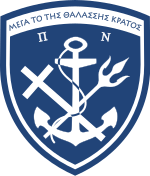 Hellenic Navy seal | |
| Founded | 1821 (de facto) 1828 (official) |
| Country | |
| Role | National defense |
| Size | c. 30,000 active personnel 121 warships & auxiliary boats, including: 13 frigates 11 submarines 19 missile boats 10 gunboats 9 tank-landing ships 6 patrol boats 4 SOC (Special Ops) 49 fleet support & other auxiliary ships 3 memorial ships 27 aircraft |
| Part of | Hellenic Armed Forces |
| Patron | St. Nicholas |
| Motto(s) | Μέγα τὸ τῆς θαλάσσης κράτος "The rule of the sea is indeed a great matter"[1] |
| Colors | Blue, white & gold |
| March | "The Aegean Sailor" |
| Engagements | Greek war of independence Balkan wars World War I World War II Operation UNIFIL Operation Desert Storm Operation Desert Shield Operation Sharp Guard Operation Enduring Freedom Operation Active Endeavour Operation IFITOS Operation Atalanta Operation Ocean Shield 2011 military intervention in Libya Operation Aginor War on Terror Operation Irini |
| Website | Hellenic Navy |
| Commanders | |
| Chief of the Navy General Staff | Nikolaos Tsounis |
| Chief of the Fleet Command | Stylianos Petrakis |
| Chief of the Hellenic Navy Logistic Support Command | Aristeidis Alexopoulos |
| Notable commanders | Admiral Andreas Miaoulis Admiral Konstantinos Kanaris Admiral Pavlos Kountouriotis Vice Admiral Ioannis Demestichas |
| Insignia | |
| Identification symbol | ΠΝ |
| Naval ensign |  |
| Naval jack |  |
| Pennant | |
The Hellenic Navy is a Green-water navy. The total displacement of the fleet is approximately 150,000 tons and it is the 22nd largest navy in the world by total number of vessels. The HN also operates a number of naval aviation units.
The motto of the Hellenic Navy is "Μέγα τὸ τῆς θαλάσσης κράτος" from Thucydides' account of Pericles' oration on the eve of the Peloponnesian War.[3][4] This has been translated as "The rule of the sea is a great matter".[1] The Hellenic Navy's emblem consists of an anchor in front of a crossed Christian cross and trident, with the cross symbolizing Greek Orthodoxy, and the trident symbolizing Poseidon, the god of the sea in Greek mythology. Pericles' words are written across the top of the emblem.
"The Navy, as it represents a necessary weapon for Greece, should only be created for war and aim to victory."
— Greek Government (1866)
History
The history of the Hellenic Navy begins with the birth of modern Greece, and due to the maritime nature of the country, it has always featured prominently in modern Greece's military history.
The Navy during the Revolution (1821–1830)
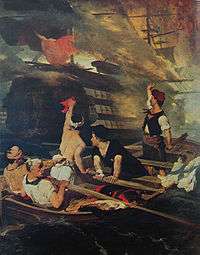
At the beginning of the Greek War of Independence, the naval forces of the Greeks consisted primarily of the merchant fleet of the Saronic islanders from Hydra, Spetsai and Poros and also the islanders of Psara and Samos. The fleet was of crucial importance to the success of the revolution. Its goal was to prevent as much as possible the Ottoman Navy from resupplying the isolated Ottoman garrisons and land reinforcements from the Ottoman Empire's Asian provinces.
Although Greek crews were experienced seamen, the light Greek ships, mostly armed merchantmen, were unable to stand up to the large Ottoman ships of the line in direct combat. So the Greeks conducted the equivalent of modern-day naval special operations, resorting to the use of fireships (Greek: πυρπολικά or μπουρλότα), with great success. It was in the use of such ships that courageous seamen like Constantine Kanaris won international renown. Under the leadership of capable admirals, most prominently Andreas Miaoulis from Hydra, the Greek fleet achieved early victories, guaranteeing the survival of the revolution in the mainland.
However, as Greeks became embroiled in civil wars, the Sultan called upon his strongest subject, Muhammad Ali of Egypt, for aid. Plagued by internal strife and financial difficulties in keeping the fleet in constant readiness, the Greeks failed to prevent the capture and destruction of Kasos and Psara in 1824, or the landing of the Egyptian army at Modon. Despite victories at Samos and Gerontas, the Revolution was threatened with collapse until the intervention of the Great Powers in the Battle of Navarino in 1827. There the Egypto-Ottoman fleet was decisively defeated by the combined fleets of the Britain, France and the Russian Empire, effectively securing the independence of Greece.
When Ioannis Capodistrias became governor of newly liberated Greece in 1828, the Greek fleet consisted of few remaining ships, which had participated in the war for independence. The first minister of "Naval affairs" was Constantine Kanaris, and the most powerful ship of the fleet at that time, the frigate Hellas, had been constructed in the United States in 1825. The Hellenic Navy established its headquarters at the island of Poros and the building of a new series of ships began at the naval base, while old ships were gradually being retired. Furthermore, continuous efforts towards the education of officers were initiated. Young people were initially trained at the military school of Scholi Evelpidon and afterwards they were transferred to the navy, as there was no such thing as a Naval Academy.[5]
In 1831, Greece descended into anarchy with numerous areas, including Mani and Hydra, in revolt. It was during this revolt that the flagship Hellas, docked at Poros, was set on fire by Admiral Andreas Miaoulis.[6] Capodistrias was assassinated a few months after.
The Royal Hellenic Navy of King Otto (1830–1860)
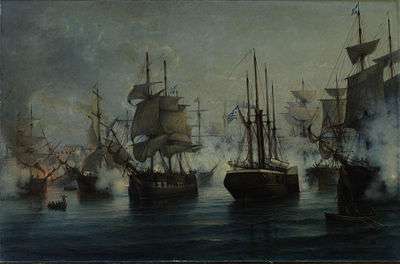
When the new King Otto arrived in the Greek capital, Nafplion, in 1832 aboard the British warship HMS Madagascar, the Greek fleet consisted of one corvette, three brigs, six schooners, two gunboats, two steamboats and a few more small vessels. The first naval school was founded in 1846 on the Corvette Loudovikos and Leonidas Palaskas was assigned as its director. However, the inefficient training of the officers, coupled with conflict between those who pursued modernization and those who were stalwarts of the traditions of the veterans of the struggle for independence, resulted in a restricted and inefficient navy, which was limited to policing the sea and the pursuit of pirates.
During the 1850s, the more progressive elements of the navy won out and the fleet was augmented with more ships. In 1855, the first iron propeller-driven ships were ordered from England. These were the steamships Panopi, Pliksavra, Afroessa, and Sfendoni.[5]
Growth of the Navy under King George (1860–1910)
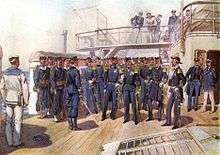

On October 29, 1863, following an enthronement ceremony in his native Copenhagen and a tour of several of the European capitals, Prince Wilhelm of Denmark arrived aboard the Greek flagship Hellas, to take up the throne as King George I of Greece. During the 1866 Cretan revolt, the ships of the Royal Hellenic Navy were in no condition to support it. Such failure led to the government awakening to the problem of naval insufficiency and the adoption of a policy stating that: "The navy, as it represents a necessary weapon for Greece, should only be created for war and aim to victory." Because of this, the fleet was supplied with new and bigger ships, reflecting a number of innovations including the use of iron in shipbuilding industry and the invention of the torpedo; with these advances, the effectiveness and the appearance of the Hellenic Navy changed.
Meanwhile, after 1878, because of the Russo-Turkish War and the need to expand the Greek navy, a new and larger naval base was established in the area of Faneromeni of Salamis and a few years later it was transferred to the area of Arapis where it remains today. At the same time the Naval Academy was founded and Ilias Kanellopoulos was made Director. A committee from France headed by Admiral Lejeune introduced a new, advanced naval organization and the methodological training of enlisted personnel through the establishment of a training school in the old building of the naval base in Poros. During the government of Charilaos Trikoupis in 1889, the fleet was further increased with the acquisition of new battleships: Hydra, Spetsai, and Psara from France. Thus, when Greece went to war in the Greco-Turkish War in 1897, the Hellenic Navy established its dominance in the Aegean Sea. However, it was unable to change the outcome of the war on land, which was a national humiliation.
In 1907, the Hellenic Navy General Staff (Γενικό Επιτελείο Ναυτικού) was founded, with then-Captain Pavlos Kountouriotis as its first head. After the war, in 1897, the Ottoman Empire embarked on a program of naval expansion for its fleet and as a response to that, in 1909, the cruiser Georgios Averof was bought from Italy. In 1910, an English naval mission arrived, headed by Admiral Tuffnel, in order to recommend improvements in the organization and training of the navy. The mission led to the adoption of the English style of management, organization and training, especially in the area of strategy.
Balkan Wars (1912–1913)
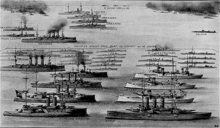
The Navy, shortly before the Balkan Wars, was composed of a fleet of destroyers and battleships. Its mission was primarily offensive, aiming at capturing the Ottoman-held islands of the Eastern Aegean, and establish naval supremacy in the area. To that end, its commander-in-chief, Rear Admiral Pavlos Kountouriotis, established a forward base at the Moudros bay at Lemnos, directly opposite the Dardanelles straits. After defeating the two Turkish sallies from the Straits at Elli (December 1912) and Lemnos (January 1913), the Aegean Sea was secured for Greece.
The Balkan Wars were followed by a rapid escalation in 1914 between Greece and the Ottoman Empire over the status of the islands of the eastern Aegean. Both governments embarked on a naval armaments race, with Greece purchasing the battleships Lemnos and Kilkis and the light cruiser Elli as well as ordering two dreadnoughts, Vasilefs Konstantinos and Salamis and a number of destroyers. However, with the outbreak of the First World War, construction of the dreadnoughts stopped.
World War I and aftermath (1914–1935)
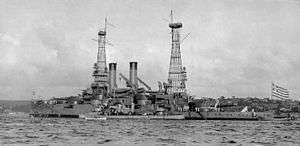
Initially during the war, Greece followed a course of neutrality, with the Prime Minister Eleftherios Venizelos favoring the Entente and pro-German King Constantine I advocating neutrality. This dispute eventually led to a deep political conflict, known as the "National Schism". In November 1916, in order to apply pressure on the royal government in Athens, the French confiscated the Greek ships. They continued to operate with French crews, primarily in convoy escort and patrol duties in the Aegean, until Greece entered the war on the side of the Allies in June 1917, at which point they were returned to Greece. Subsequently, the Navy took part in the Allied operations in the Aegean, in the Allied expedition in support of Denikin's White Armies in the Ukraine, and in limited operations during the Greco-Turkish War of 1919–1922 in Asia Minor.
After Greece's defeat, the 1920s and early 1930s were a politically turbulent period, with the economy in a bad state, so the Navy received no new units, apart from the modernization of four destroyers and the acquisition of six French submarines in 1927 and four Italian destroyers in 1929.
World War II (1935–1950)
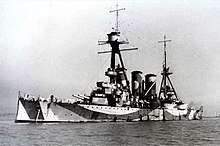
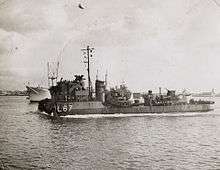
In 1938, Greece ordered four modern Greyhound-class destroyers in British shipyards, making a serious step towards modernization. The outbreak of war in Europe, however, allowed only two to be delivered. Greece entered World War II with a navy consisting of two battleships, one armoured cruiser, 14 destroyers, and six submarines.[7]
During the Greco-Italian War, the Navy took over convoy escort missions in the Ionian Sea and even embarked on three raids against the Italian supply convoys in the Strait of Otranto, although without success. The most important role was given to the submarines, which although obsolete, sank some Italian cargo ships in the Adriatic, losing one submarine in the process. The Greek submarine force (six boats) was however too small to be able to seriously hinder the supply lines between Italy and Albania (between 28 October 1940 and 30 April 1941, Italian ships made 3,305 voyages across the Otranto straits, carrying 487,089 military personnel, including 22 field divisions, and 584,392 tons of supplies while losing overall only seven merchant ships and one escort ship).[8]
When Nazi Germany attacked Greece, the RHN suffered heavily at the hands of the Luftwaffe, with 25 ships, including the old battleship, now artillery training ship, Kilkis and the hulk of her sister Lemnos, lost within a few days in April 1941. It was then decided to shift the remaining fleet (one cruiser – the famous Georgios Averof – three destroyers and five submarines) to join up with the British Mediterranean Fleet at Alexandria.
As the war progressed, the number of Hellenic Royal Navy vessels increased after the concession of several destroyers and submarines by the British Royal Navy. The most notable aspects of the Hellenic Royal Navy's participation in World War II include the operations of the destroyer Vasilissa Olga which, until sunk in Leros on September 23, 1943, was the most successful Allied destroyer in the Mediterranean Sea; the participation of two destroyers in Operation Overlord; and the story of the destroyer Adrias, which while operating close to the coast of Kalymnos in October 1943 hit a mine, resulting in the loss of the vessel's prow, while blowing the two-gun forward turret over the bridge. After some minor repairs at Gümüşlük Bay in Turkey Adrias managed to return to Alexandria in a 400-mile (640 km) trip, even though all the forepart of the ship, up to the bridge, was missing.
Post-war era (1950–1980)
.png)
After World War II, the Royal Hellenic Navy was significantly strengthened by the concession of British and Italian ships. The organisation also changed in line with modern naval doctrines of that era after the entrance into NATO in 1952. At the beginning of the 1950s, US military aid formed the core of the country's armed forces. The Royal Hellenic Navy received the first Bostwick-class destroyers which took on the name Beasts (Θηρία), while withdrawing the British ones.
The next significant change was during the early 1970s, when Greece was the first Mediterranean naval force to order missile-equipped fast attack craft (Combattante II) and the Type 209 submarines, whereas US military aid continued in the form of FRAM II type destroyers. In 1979, the Hellenic Navy placed an order in the Netherlands for two modern Standard-class frigates (the Elli class). These were the first acquisitions of new main surface vessels, rather than the use of second-hand ships, in almost four decades.
Modern era (1980-2009)
_underway_in_the_Pacific_Ocean_on_2_August_1984_(6392223).jpg)
The arrivals of Hydra class (MEKO 200 HN) and more Standard-class frigates along with the orders for more missile corvettes, Poseidon-class (Type 209) submarines and naval helicopters allowed the retirement of the obsolete vessels. Greece also received four Charles F. Adams-class destroyers from the US Navy in 1991–1992. All four were decommissioned after only ten years in service, since their electronics and armament eventually became obsolete and they required large crews. The advance continued when Greece ordered Type 214 submarines that feature an air-independent propulsion (AIP) system, Sikorsky S-70B-6/10 Aegean Hawk helicopters and Project 1232.2 Zubr-class hovercraft from Russia and Ukraine. Later actions included the modernization of Standard-class frigates with new electronics and radar systems and the modernization of Glaukos and Poseidon-class submarines with new sonars, electronics and air-independent propulsion engines (programs Neptune I/II).
The Navy from 2009 to 2019 & future plans
Overview
The Hellenic Navy maintains a large number of surface vessels and submarines in its inventory. However, the 10 years of economic recession (2009-2019) that affected the country particularly hard, have also affected the Navy's development plans. The fleet is ageing and the vast majority of warships in active service should have been already replaced by modern designs. The Hellenic Navy has not yet confirmed it will be purchasing 2 FDI Belharra frigates from France with an option for 2 more, as an almost certain decision, was put on hold in July 2020. Greece has signed on to a program between Italy and France in making a new multirole heavy corvette, with Spain joining as well. The program, dubbed the European Patrol Corvette, has also been inserted in the EU’s so-called Permanent Structured Cooperation. Naviris expected the EU fund to issue a Request for Proposal for projects in 2020, with proposals to then be submitted by industry in 2021, and for decisions on fund allocation to be made the same year[9]. Also, plans for the Hellenic Navy to acquire the Sa'ar 72 Israeli corvette of the new Themistocles class came to fruition after an agreement signed on June 2020, with exclusive production in Greece.
Frigates and heavy corvettes
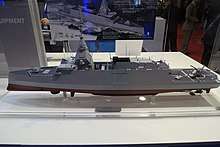
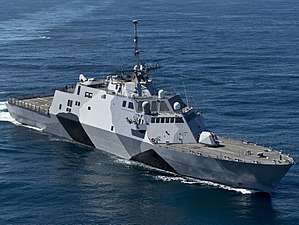
Frigates are the main heavy ships of the Navy, with 70% of the Hydra class frigates having an advanced anti-aircraft missile launching system. However, there is no dedicated Anti-aircraft Warfare (AAW) platform in the fleet since the Charles F. Adams class destroyers were decommissioned in the late 90s. The oldest ship in the frigate fleet is just over 40 years old (HS Kountouriotis, commissioned in 1978) while the youngest ship is just over 20 years old (HS Salamis, commissioned in 1998). None of the ships is equipped with a remote weapon station (RWS) for the purpose of asymmetric warfare and coastal defence and the electronic countermeasures systems (ECM) are absent or obsolete. Raytheon will soon begin the installation of new electro-optical systems on the ships that are not yet equipped with such sensors. It is certain that Hydras will undergo a modernization program but its scale is not yet known. Plan for the Hydras is to extend their operational lifespan well into the 2030s. However, the Elli class frigates need to be replaced by new designs.
The acquisition of two, with an option for two more, Naval Group FDI frigates with high-end AAW and deep missile strike (DMS utilising Scalp EG Naval) capabilities from France was put on hold in July 2020, despite an intense interest initially expressed by the Navy. Main reasons for this reservation by the Greek Government, were reported to be the increased cost of almost €3 billion for only 2 units, the exclusion by the French of co-production and the delayed delivery of the first unit, placing it in 2025 at the earliest.[11][12] Meanwhile, the United States have proposed the acquisition of four Multi-Mission Surface Combatants (MMSCs), also known as Littoral combat ships, acting as an intermediate or more permanent solution, that are in full production and already tested and in use by the US Navy. Nevertheless, the final decision on which type of frigate the Navy is eventually going to transition to, is expected by late 2020.
It is almost certain that two types will replace the Ellis, in order to maintain a ceiling of at least 10 frigates/corvettes. A floating scenario was the purchase of heavy corvettes to replace a number of old Ellis. This scenario has become increasingly more possible, after Greece joined Italy and France in the European Patrol Corvette (EPC/PESCO)[13] consortium in early 2020 for the construction of a new advanced 3,000 ton corvette, with Spain joining the program as well. New ships, for all involved Navies, are not likely to enter service before 2027 or 2030 at the earliest.[14]
Submarines
Greece maintains a mixed fleet of modern and older submarine units. In December 2019, the Hellenic Ministry of Defence resolved a lingering issue, regarding the new Type-214 (Papanikolis class) torpedoes. An order for new multi-role (AV/AS) heavyweight torpedoes was placed, with arrivals scheduled within the first months of 2020. The six older and non-modernized Type-209 units (Poseidon and Glavkos classes) will be gradually retired, without any replacement announced yet. The optimistic scenario is replacement with four additional Type-214s, reaching a ceiling of eight units of this type. By 2030, the recently upgraded Type-209/1500 AIP (HS Okeanos, former Type-209/1200) will have exceeded 50 years since entering service; therefore it is questionable whether it will still be part of the Greek fleet by that time.
Other surface combatants
There were two new Roussen class Fast Attack Missile Craft (FAMC) under construction, bringing the number of vessels of this type up to seven; The 6th ship was commissioned operational in July 2020,[15] with the 7th and final ship expected Autumn 2020. This was after a more than ten-year delay due to financial and structural problems faced by Elefsis Shipyard that was contracted to build the ships. There are no changes in the initial design, despite 20 years since the first vessel in the class entered service. The majority of the FAC were built in the late ‘70s. Four of them have been modernised extensively and the new ships have integrated all updates. All older vessels of other types, with the exemption of three Votsis class boats which are about to be retired soon with the introduction of the new Roussens, have replaced their old MM38 and Penguin missile systems with Harpoon launchers. In addition, the boats that have no electro-optical tracking (Mirador) sensor will receive a new Miltech system.
The fleet also consists of ten gunboats. With the exception of the four Machitis class (Osprey HSY-56A), the rest of the gunboats need modernization and, some of them, replacement. The two Asheville class boats are at least 50 years old. The remaining four boats (Osprey-55 and HSY-56) have already received new electro-optical systems. On June 16, 2020, ONEX Neorion Shipyards SA in the Greek island of Syros and Israel Shipyards LTD signed a cooperation agreement for the construction of the Themistocles class corvette during Greek PM’s visit to Israel. This is a multipurpose warship based on the Israeli Sa'ar 72-class corvette design, at 72 meters length and displacement of around 800 tons. It will be able of speeds above 30 knots with an extended endurance. It can operate a medium size marine helicopter, but also supports unique possibilities of deploying Special Forces units. The agreement was for the construction in Greece of 7 vessels, with an option for 6 more.[16] These will replace an equal number of older gunboats.
In February 2020, at a special event held at the Hellenic Institute of Naval Technology (HINT), the technical director of the Unit of Submersibles and Hellenic Navy Works of Hellenic Shipyards Co., presented project Aginor.[17] The project is the development and construction, in collaboration with the Navy, of an advanced Asymmetric Warfare Vessel (AWV) that uses the latest technologies and composite materials. According to the company, the first prototype is already in development. The vessel will be capable of a number of missions including insertion and extraction of Special Operations Forces, interdiction and coastal patrol, as well as search and rescue (SAR) operations.
In April 2020 the Navy received the first four Mark V Special Operations Craft, ordered via the United States Excess Defense Articles programme. The craft are expected to be utilised by the Underwater Demolition Command.[18]
Aircraft
In 2019, the U.S. State Department cleared a $600 million foreign military sale (FMS) of seven MH-60R Seahawk multi-mission helicopters to Greece.[19] In July 2020, Greece signed a contract for the purchase of 4 new units, via this program. A decision was made in 2014 for the re-activation of existing Lockheed P-3B Orions and their submission to a program of overhaul, upgrade and service life extension. The contract with Lockheed Martin included the return of one aircraft to airworthy condition with the existing mission equipment as an "interim solution" and the complete modernization and upgrade of four other aircraft in Hellenic Aerospace (HAI). The option included the complete modernization and upgrade of that aircraft as well. The "interim solution" aircraft has been already delivered, while all the remaining aircraft are expected to be delivered by 2023.
Chain of command
 |
| Organization |
|---|
| History |
|
| Standing Deployments |
|
Main commands
| Greek | English translation | Location |
|---|---|---|
| Γενικόν Επιτελείον Ναυτικού (ΓΕΝ) | Hellenic Navy General Staff | Athens |
| Αρχηγείον Στόλου (ΑΣ) | Fleet Headquarters | Salamis Island |
| Ναυτική Διοίκηση Αιγαίου (ΝΔΑ) | Aegean Sea Naval Command | Piraeus |
| Ναυτική Διοίκηση Ιονίου (ΝΔΙ) | Ionian Sea Naval Command | Patras |
| Ναυτική Διοίκηση Βορείου Ελλάδος (ΝΔΒΕ) | Northern Greece Naval Command | Thessaloniki |
| Διοίκηση Ναυτικής Εκπαίδευσης (ΔΝΕ) | Naval Training Command | Skaramagas |
| Διοίκηση Διοικητικής Μέριμνας (ΔΔΜΝ) | Logistics Command | Athens |
| Διοίκηση Αεροπορίας Ναυτικού (ΔΑΝ) | Navy Aviation Command | Grammatiko |
| Ναύσταθμος Κρήτης | Crete Naval Base | Souda Bay, Chania |
| Ναύσταθμος Σαλαμίνας | Salamis Naval Base | Salamis Island |
| Υδρογραφική Υπηρεσία | Hydrographic Service[21] | Athens |
| Υπηρεσία Φάρων | Lighthouse Command[22] | Piraeus |
Combat arms
- Διοίκηση Φρεγατών (ΔΦΓ) Frigate Command
- Διοίκηση Πλοίων Επιτηρήσεως (ΔΠΕ) Surveillance Ships Command, formerly Διοίκηση Κανονιοφόρων (ΔΚΦ) Gunboat Command
- Διοίκηση Ταχέων Σκαφών (ΔΤΣ) Fast Attack Craft Command
- Διοίκηση Υποβρυχίων (ΔΥ) Submarine Command
- Διοίκηση Αμφιβίων Δυνάμεων (ΔΑΔ) Amphibious Assault Forces Command
- Greece does not have a marine corps established as a separate branch attached to the naval service. Instead, the Army includes the 32nd Marine Brigade (32η Ταξιαρχία Πεζοναυτών); the Navy provides the landing craft etc.
- Διοίκηση Υποβρυχίων Καταστροφών (ΔΥΚ) Underwater Demolition Command
- Διοίκηση Αεροπορίας Ναυτικού (ΔΑΝ) Navy Aviation Command
- 1η Μοίρα Ελικοπτέρων Ναυτικού (ΜΕΝ 1) 1st Navy Helicopter Squadron (AB-212 ASW), 112th Combat Wing, Elefsis, 38°08′31″N 23°57′03″E
- 2η Μοίρα Ελικοπτέρων Ναυτικού (ΜΕΝ 2) 2nd Navy Helicopter Squadron (S-70B Aegean Hawk), 112th Combat Wing, Elefsis, 38°08′31″N 23°57′03″E
- Μοίρα Αεροσκαφών Ναυτικού (ΜΑΝ) Navy Aircraft Squadron, 112th Combat Wing, Elefsis, currently with no active aircraft. 38°04′13″N 23°33′56″E
- Ελικοσταθμός Αμφιάλης = Amfiali Heliport 37°59′30″N 23°34′28″E
Combat support arms
- Διοίκηση Ναρκοπολέμου (ΔΝΑΡ) Minesweeper Command
Combat service support
- Σχολή Εξάσκησης Ναυτικής Τακτικής (ΣΕΝΤ) Naval Tactical Training School (under Fleet Headquarters)
Equipment
Ships
The Hellenic Navy's fleet of warships and auxiliary boats is harboured in the two major HN naval bases at Salamis Island near Piraeus and at Souda Bay on the island of Crete. Internationally, the Navy used the prefix HS (Hellenic Ship) for its vessels.
Frigates
.jpg)
The Hellenic Navy relies mainly on frigates as its primary surface heavy boats. The fleet consists of thirteen frigates. The types operated are the Hydra class (Type: Meko-200HN) and the Elli class (Type: Kortenaer). The Elli-class frigates HS Elli and HS Limnos were sold to Greece during construction, the rest were bought directly from the Dutch Navy. The Hydra-class vessels were constructed in Greece by Hellenic Shipyards Co., except from HS Hydra that was constructed by the German company Blohm and Voss based in Hamburg. Modernization of six frigates was completed in 2010.[24] The intention for the Hydra-class vessels was, as of February 2015, to be modernised with a €400 million upgrade that would extend their operational life to 2035.[25]
In 2018, Greece entered talks with France for the purchase of the next generation, multipurpose, mid-size, stealth frigate (FTI) "Belharra",[26][28] that is being developed by the French company DCNS (now Naval Group) and has already been selected by the French Navy as its next generation platform. As an alternative at the time, the Hellenic Navy was also proposed the Greek-designed, next-gen, stealth corvette/frigate "ALS Class-100",[29][30] developed by the Greek company NSD Group.
In July 2019[31] and later in October of the same year, a top Naval Group representative and the French Minister of Defence confirmed that, after signing a Letter of Intent (LoI),[32][33] Greece and France were actively implementing a bilateral agreement, that included the purchase from Greece of two multi-purpose FTI frigates with an option for two additional ships and relative infrastructure for future co-production for a cost of $2 billion, starting in 2023.[34][35] The construction of the first Greek FTI vessel would begin immediately after the completion of the first French ship, subsequently involving fully the Hellenic Navy in the FTI Belh@rra project. Thereafter, cost for construction of future vessels would decrease significantly, taking into account Greece's participation with coproduction. The configuration for the Hellenic Navy vessels would differ from the French ones, only in respect to the interest of Greece for integration of wide-range, deep-strike missiles (MBDA's Naval Cruise Missile), that could be exclusively supported by the Greek configuration.[36] In July 2020 however, the almost certain final decision for purchase was put on hold, since some of these initial aspects of the agreement were negatively reviewed during talks between the parties and while the Navy was now examining additional options.
The Greek frigate HS Psara carries three reliquaries permanently on its onboard historical exhibition. Two contain the taxidermic hearts of Greek War of Independence heroes Admiral Constantine Kanaris and Admiral Andreas Miaoulis and one reliquary contains the remains of heroine Rear Admiral (posthumous) Laskarina Bouboulina. The frigate's exhibition can be visited when the ship opens to the public during National Holidays and celebrations.
Gunboats
_mail_transfer.jpg)
The Hellenic Navy operates ten gunboats of the Osprey and Asheville classes. Both Osprey HSY-55 and Osprey HSY-56A classes are designed by the Hellenic Navy following a modular concept so that weapons and sensors can be changed as required. They were built by Hellenic Shipyards (HSY) in Greece. These vessels are similar in appearance to Osprey 55-class gunboats. The first pair was ordered on 20 February 1990. HS Pyrpolitis was launched on 16 September 1992 and HS Polemistis on 21 June 1993. Each ship can carry 25 fully equipped troops. Alternative guns and Harpoon missiles can be fitted as required. Pyrpolitis was renamed Kasos on 11 November 2005, after the island of Kasos in the Dodecanese. The ship is based in the area of Kasos, and the name recognises the island and the Kasos Massacre during the Greek War of Independence.[37] The two Asheville Class gunboats are former US Navy vessels, bought and transferred to Greece in 1989.
Missile boats
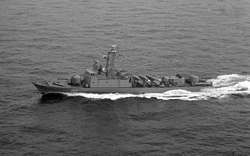
The fleet consists of nineteen missile boats also known as fast attack missile craft. Two new ships (P78 and P79) entered service in 2019. The main purpose of these vessels is offensive anti-ship warfare. The Hellenic Navy operates four types of missile boats. These are the Roussen (Super-Vita), Laskos (La Combattante III), Kavaloudis (La Combattante IIIb) and Votsis (La Combattante IIa) classes. The La Combattante III and La Combattante IIIb classes were upgraded in 2006. For the La Combattante III craft, Thales delivered a TACTICOS combat management system, including four multi-functional operator consoles, one surveillance radar, a fire-control tracking system, one electro-optical tracking and fire control system, an integrated low-probability-of-interception radar, two target designation sights and a tactical data link. The weapon suite of the La Combattante IIIs remained unchanged. Thales was also responsible for the integration of existing guns, surface-to-surface missiles and torpedoes. The La Combattante IIa ships are scheduled to be decommissioned upon completion of the two newly ordered Roussen gunboats.
Submarines
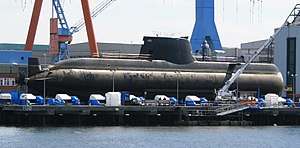
The Hellenic Navy Submarine Command operates eleven submarines of four types. The newest and most advanced type operated is the Type 214 Papanikolis class, which is widely considered to be among the most advanced conventional (non-nuclear) propulsion submarines in service with naval forces at the moment. The Type 214 is a diesel-electric submarine developed by the German Howaldtswerke-Deutsche Werft GmbH (HDW). It features diesel propulsion with an air-independent propulsion (AIP) system using Siemens polymer electrolyte membrane (PEM) hydrogen fuel cells. A contract to build four boats for the Hellenic Navy was signed between February 2000 and June 2002. The first boat was built at HDW in Kiel, Germany, and the rest at Hellenic Shipyards Co. in Skaramangas, Greece. The Hellenic Navy named them the Papanikolis class. Other types operated are the 209/1100 Glavkos class, the 209/1200 Poseidon class and one boat of the 209/1500 AIP Okeanos class. The Glavkos submarines were upgraded with the "Neptune I" modernisation program and the Poseidon and Okeanos vessels with the "Neptune II" program. The Okeanos upgrade included AIP capabilities very similar to Type 214 so extensive to justify HS Okeanos as a new, separate class when compared to the rest of Type 209/1200 vessels. New dimensions are similar to Type 214 boats.
Landing boats
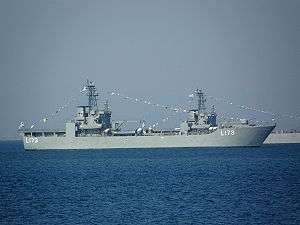
The Hellenic Navy currently operates nine tank landing ships (LST), five of the Greek-built Jason class and four heavy military hovercraft of the Ukrainian/Russian-built Zubr class. The Jason landing craft are capable of transporting 287 troops plus 22 battle tanks or any other combination of other armoured vehicles. The Zubr craft have a military lift of total 130 tonnes of cargo with three battle tanks, eight armoured vehicles, ten personnel carriers and 140 troops or combinations of those and a speed of 40 knots when fully loaded. The Zubr class (Project 1232.2 / NATO codename: "Pomornik") is an air-cushioned landing craft (LCAC). This class of military hovercraft is, as of 2012, the world's largest, with a standard full load displacement of 555 tons.[38] The hovercraft is designed to sealift amphibious assault units (such as marines and tanks) from equipped or non-equipped vessels to non-equipped shores, as well as transport and plant naval mines. The purchase of HS Cephalonia for the Hellenic Navy was the first time a Soviet design had been built for and purchased by a NATO member.[39][40][41]
Replenishment and other vessels
The Hellenic Navy operates four Mark V special operations vessels (SOC), fifteen replenishment and support ships including petroleum tankers, water tankers and auxiliary vessels. It also operates two Greek-built transport ships of the Pandora class, six coastline patrol boats, four minesweepers, three torpedo retrievers, seventeen tugboats (both open sea and harbour), four oceanographic & scientific research vessels and two lighthouse tenders. The Navy also preserves three memorial ships including the Pisa-class armoured cruiser HS Georgios Averof which is the only armoured cruiser worldwide still in existence and, although it is permanently a harboured museum ship, is ceremoniously considered in active-service carrying the Rear Admiral's Rank Flag.
Aircraft
The Hellenic Navy operates naval aviation units under the Navy Aviation Command,[43] that resulted from the amalgamation of the Navy Helicopter Command and the 353rd Naval Cooperation Squadron, which was run jointly with the Hellenic Air Force.
It currently operates:[44]
- Lockheed Martin P-3B Orions as maritime patrol and naval cooperation platforms. Four upgraded aircraft have gradually started to re-enter the fleet, after a $142 million contract for their upgrade was awarded in February 2016 to Lockheed Martin.[45]
- Sikorsky S-70B Seahawks, which is the export variant of the Sikorsky SH-60 Seahawk. Furthermore, the Greek variant is the S-70/B-6 Aegean Hawk, which is a blend of the SH-60B and F-models.
- Aérospatiale Alouette IIIs, mainly used for missions such as aerial observation, photography, transport and training.
- Agusta Bell AB-212 ASWs, which is the military variant of the Bell 212, dedicated to anti-submarine warfare.
Ranks and insignia
Commissioned officers
| NATO code | OF-10 | OF-9 | OF-8 | OF-7 | OF-6 | OF-5 | OF-4 | OF-3 | OF-2 | OF-1 | OF(D) | Student officer | ||||||||||||||||||||||||
|---|---|---|---|---|---|---|---|---|---|---|---|---|---|---|---|---|---|---|---|---|---|---|---|---|---|---|---|---|---|---|---|---|---|---|---|---|
(Edit) |
No equivalent |   |
  |
  |
  |
  |
  |
  |
  |
  |
  |
  |
No equivalent | |||||||||||||||||||||||
| Admiral | Vice Admiral | Rear Admiral | Commodore | Captain | Commander | Lieutenant Commander | Lieutenant | Sub Lieutenant | Ensign | Officer Designate | ||||||||||||||||||||||||||
| Ναύαρχος | Αντιναύαρχος | Υποναύαρχος | Αρχιπλοίαρχος | Πλοίαρχος | Αντιπλοίαρχος | Πλωτάρχης | Υποπλοίαρχος | Ανθυποπλοίαρχος | Σημαιοφόρος | Σημαιοφόρος Επίκουρος Αξιωματικός | ||||||||||||||||||||||||||
NCOs and enlisted
| NATO Code | OR-9 | OR-8 | OR-7 | OR-6 | OR-5 | OR-4 | OR-3 | OR-2 | OR-1 | |||||||||||||||||||||||||||
|---|---|---|---|---|---|---|---|---|---|---|---|---|---|---|---|---|---|---|---|---|---|---|---|---|---|---|---|---|---|---|---|---|---|---|---|---|
(Edit) |
  |
 |
 |
 |
 |
 |
 |
 |
No equivalent |  male |
 female |
No equivalent |
male |
female | ||||||||||||||||||||||
| Warrant Officer | Master Chief Petty Officer | Senior Chief Petty Officer | Chief Petty Officer | Leading Seaman | Seaman | |||||||||||||||||||||||||||||||
| Ανθυπασπιστής | Αρχικελευστής | Επικελευστής | Κελευστής | Δίοπος | Ναύτης | |||||||||||||||||||||||||||||||
Hellenic Navy flags
.svg.png) Royal HN Naval Ensign (1833–1858)
Royal HN Naval Ensign (1833–1858).svg.png) Royal HN Naval Ensign (1863–1924 and 1935–1970)
Royal HN Naval Ensign (1863–1924 and 1935–1970)
- Royal HN Naval Jack, 1935
 HN Naval Jack
HN Naval Jack Minister of Defence flag
Minister of Defence flag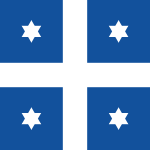 HN 4-star Admiral's Flag
HN 4-star Admiral's Flag HN Senior Officer's flag
HN Senior Officer's flag HN Commissioning Pennant
HN Commissioning Pennant
Photo gallery
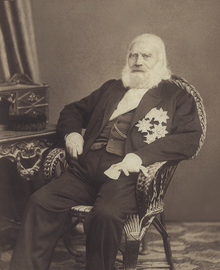 Admiral and War of Independence hero Constantine Kanaris (1793–1877)
Admiral and War of Independence hero Constantine Kanaris (1793–1877)- Captain, later Rear Admiral (Posthumous) and War of Independence heroine Laskarina Bouboulina (1771–1825)
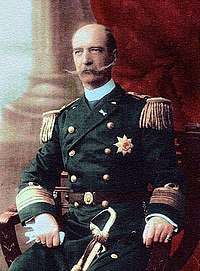 King George in Admiral's uniform of the Hellenic Navy
King George in Admiral's uniform of the Hellenic Navy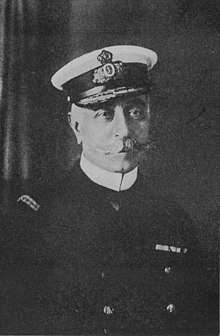 Admiral and President of Greece Pavlos Kountouriotis (1855–1935)
Admiral and President of Greece Pavlos Kountouriotis (1855–1935)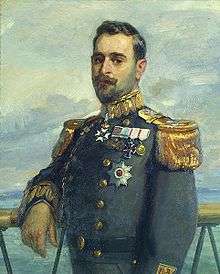 Portrait of Rear Admiral Sofoklis Dousmanis (1868–1952)
Portrait of Rear Admiral Sofoklis Dousmanis (1868–1952)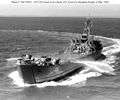 LST HS Syros undergoing trials, 1964
LST HS Syros undergoing trials, 1964 Frigate HS Spetsai in Trieste
Frigate HS Spetsai in Trieste Hydrographic vessel HS Nautilus in Syros harbour
Hydrographic vessel HS Nautilus in Syros harbour HS Pandora, a passenger ship connecting Piraeus Harbor and Salamis Naval Base
HS Pandora, a passenger ship connecting Piraeus Harbor and Salamis Naval Base HS Psara in Operation Enduring Freedom
HS Psara in Operation Enduring Freedom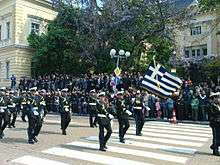
_at_the_NATO_Maritime_Interdiction_Operational_120512-N-FV216-014.jpg) A Hellenic Navy SOF (special operations forces) instructor conducts small arms training with U.S. sailors aboard the HN training ship Aris
A Hellenic Navy SOF (special operations forces) instructor conducts small arms training with U.S. sailors aboard the HN training ship Aris
See also
Notes
References
- Thucydides (1910). "1.143.5". The Peloponnesian War. London; New York: J. M. Dent; E. P. Dutton. At the Perseus Project.
- Thucydides (1942). "1.143.5". Historiae in two volumes (in Greek). Oxford: Oxford University Press. At the Perseus Project.
- Thucydides, History of the Peloponnesian War, 1.143.
- Official website of the Hellenic Navy Archived 2007-08-22 at the Wayback Machine
- Politics and Statecraft in the Kingdom of Greece, John Anthony Petropulos, Princeton University Press, 1968.
- Vice Admiral C. Paizis-Paradellis, HN (2002). Hellenic Warships 1829–2001 (3rd Edition). Athens, Greece: The Society for the study of Greek History. p. 205. ISBN 960-8172-14-4.
- Pier Filippo Lupinacci, Vittorio Emanuele Tognelli, La difesa del traffico con l'Albania, la Grecia e l'Egeo, Ufficio Storico della Marina Militare, Rome 1965, pp. 47-49.
- https://www.defensenews.com/global/europe/2020/02/07/spain-seen-joining-greece-france-italy-on-european-patrol-corvette-program/
- "Frégates FDI : la France touchée, coulée en Grèce ?". La Tribune (in French). Retrieved 31 July 2020.
- "Greece's sudden "no" for French Belharra frigates amidst rising tensions with Turkey". ARMYNOW.NET. 22 July 2020. Retrieved 31 July 2020.
- Kington, Tom (7 February 2020). "Spain seen joining Greece, France, Italy on European Patrol Corvette program". Defense News. Retrieved 9 February 2020.
- Archus, Dorian (11 May 2020). "Spain officially joins European Patrol Corvette (EPC) program". Naval News. Retrieved 30 June 2020.
- Vavasseur, Xavier (31 July 2020). "Hellenic Navy Commissioned its 6th Roussen-class FACM". Naval News. Retrieved 31 July 2020.
- News, Bloomberg (23 June 2020). "Shipyards in Greece and Israel Agree to Build Navy Corvette - BNN Bloomberg". BNN. Retrieved 23 June 2020.
- Epachtitis, Thanos S. (14 February 2020). "Ελληνικά Ναυπηγεία Α.Ε.: Το σκάφος Ανορθοδόξου Πολέμου ΑΓΗΝΩΡ". Πτήση & Διάστημα (in Greek). Retrieved 15 February 2020.
- Bozinovski, Igor (March 7, 2018). "Greece to acquire ex-US Mark V speedboats". Jane's Information Group.
- "Greece Approved to Purchase MH-60R Helicopters from US". Overt Defense. 16 July 2019. Retrieved 31 July 2020.
- Heyman, Charles (2011). The Armed Forces of the European Union 2012–2013. Pen & Sword Books Ltd. p. 53.
- http://www.hnhs.gr/
- "Υπηρεσία Φάρων". Hellenicnavy.gr. Archived from the original on 2010-01-11. Retrieved 2009-08-06.
- "DefenceNet – HN's future planning and new procurement policy". Defencenet.gr. Archived from the original on 2009-12-10. Retrieved 2009-08-06.
- Scott, Richard (4 February 2015). "Greece scopes plan for MEKO 200HN mid-life modernisation". IHS Jane's Defence Weekly. Retrieved 2015-07-14.
- Vavasseur, Xavier (6 June 2019). "Greece Sends LOI to France for Belharra Frigates, Looking for Financing". Naval News. Retrieved 10 October 2019.
- Article in Greek. "Belh@rra: The New Frigate on the horizon". Defence & Diplomacy. Retrieved 27 March 2019.
- Article in Greek. "The Greek Designed frigate ALS CLASS 100". Flight and Space magazine. Retrieved 27 March 2019.
- Article in Greek. "ALS CLASS 100 Multi-Purpose Corvette". Hellenic Institute of Naval Technology. Retrieved 27 March 2019.
- Archus, Dorian (27 July 2019). "Hellenic Navy's Eyes Locked on Belharra Class Frigates". Naval News. Retrieved 10 October 2019.
- "Greece signs letter of intent with France for two FDI frigates | Jane's 360". www.janes.com. Retrieved 16 October 2019.
- Vavasseur, Xavier (11 October 2019). "Greece, France sign Letter of Intent for Two 4,000 tons Frigates". Naval News. Retrieved 12 October 2019.
- Team, ΤοΒΗΜΑ (2 September 2019). "Δυο φρεγάτες αγοράζει η Ελλάδα από την Γαλλία". Ειδήσεις - νέα - Το Βήμα Online (in Greek). Retrieved 10 October 2019.
- In Greek (10 October 2019). "Προσύμφωνο για την αγορά δύο φρεγατών Belh@rra υπογράφει ο Παναγιωτόπουλος". ProtoThema (in Greek). Retrieved 10 October 2019.
- Vavasseur, Xavier (26 July 2019). "France & Greece Working on G-to-G Agreement for Multi-Mission Frigates". Naval News. Retrieved 10 October 2019.
- "Κ/Φ ΚΑΣΟΣ (Ρ 57)" (in Greek). hellenicnavy.gr. Retrieved 26 October 2018.
- Hellenic Navy (2008). "Hellenic Command Amphibious Forces: Ships". Hellenic Navy. Archived from the original on 2009-03-09. Retrieved 2009-04-18.
- Hellenic Navy (2008). "Hellenic Command Amphibious Forces: Introduction". Hellenic Navy. Archived from the original on 2009-03-22. Retrieved 2009-04-18.
- Kitov, Vladimir (2000-11-04). "Almaz launches NATO-bound craft". The Russia Journal. Archived from the original on 2010-02-13. Retrieved 2009-04-18.
- Titova, Irina (2000-12-29). "City Shipyard Hovercraft Is 1st Delivery to NATO State". The St. Petersburg Times. Archived from the original on 2011-06-05. Retrieved 2009-04-18.
- "Τελετή 'Ιδρυσης Διοίκησης Αεροπορίας Ναυτικού" (in Greek). Hellenic Navy. 23 January 2018.
- "Aircraft Fleet". Hellenic Navy Official Website. Retrieved 27 March 2019.
- "Greek navy takes initial reactivated P-3B". Flight Global. Retrieved 5 June 2019.
Further reading
| Wikimedia Commons has media related to Hellenic Navy. |
- Official Website of the Hellenic Navy. Note regarding copyright: The Hellenic Navy allows free use and distribution of images from their web site with proper attribution, however they have no set copyright policy for derivative work. See also appropriate template from Greek Wikipedia: el:Template:ΠΔΕΠΝ.
- Zisis Fotakis (2005). Greek Naval Strategy and Policy 1910–1919 (Naval Policy and History). Routledge. ISBN 978-0-415-35014-3.
- Andrew Toppan (2002). "World Navies Today: Greece". Retrieved 2008-07-04.: Excellent resource with details for ships of the Hellenic Navy. Caution: List not updated since 2002.
- Royal Hellenic or Greek Navy in World War I, including warship losses
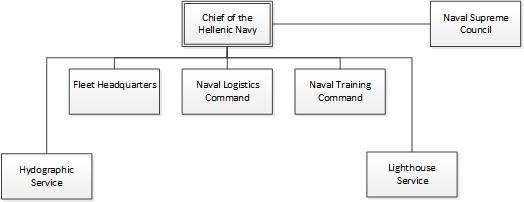
.svg.png)